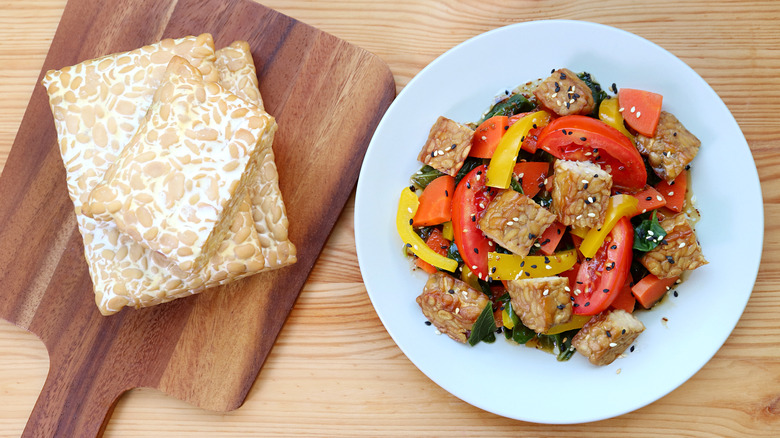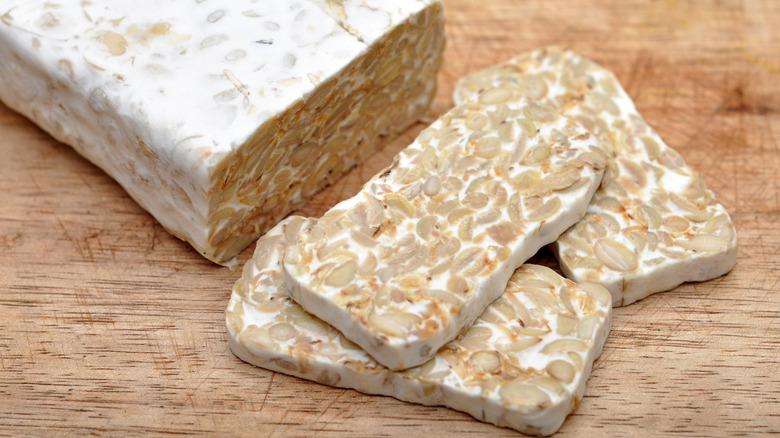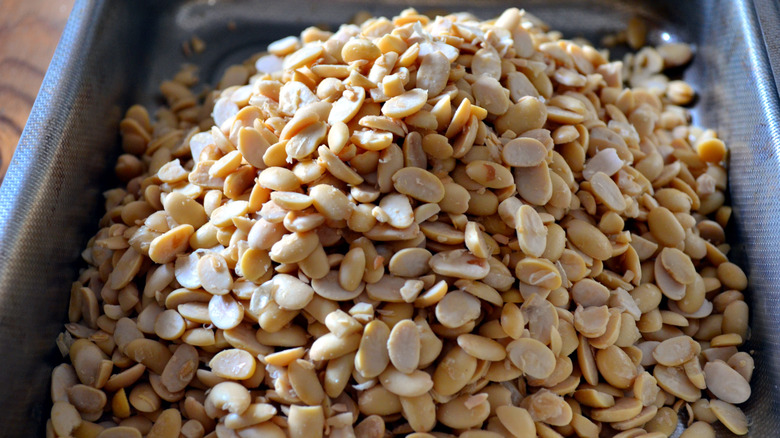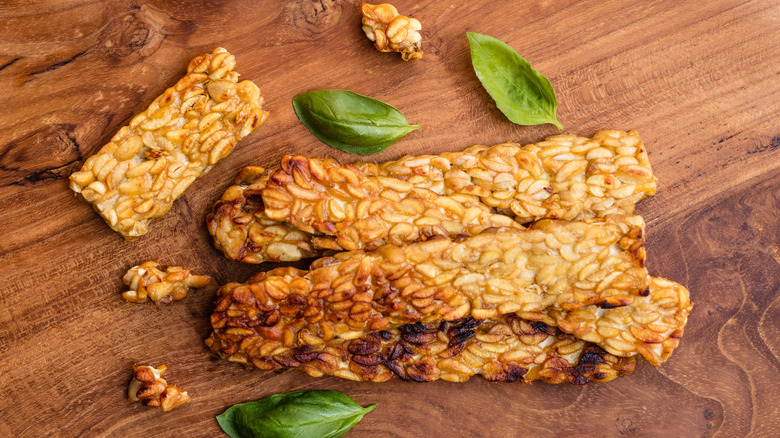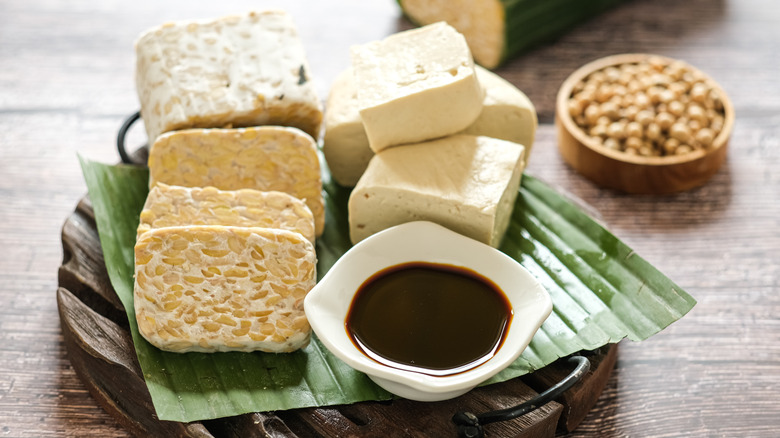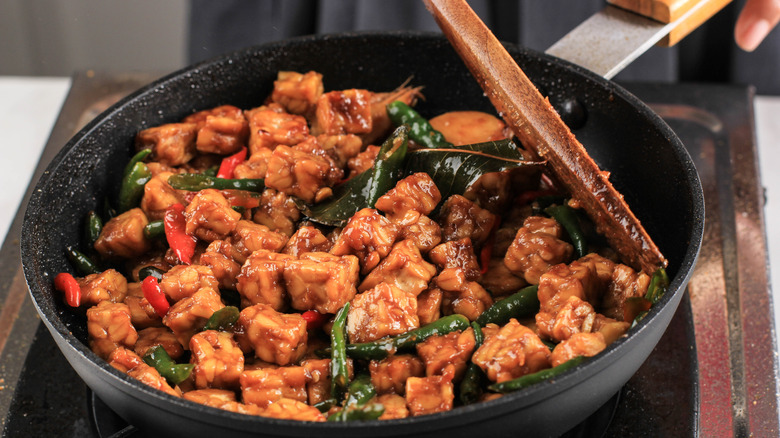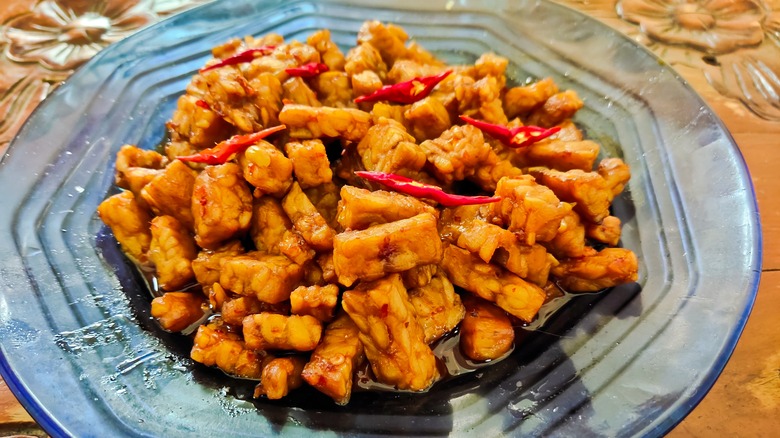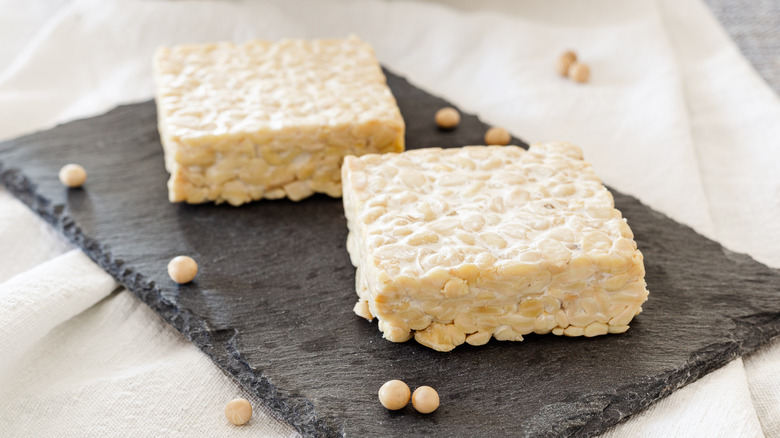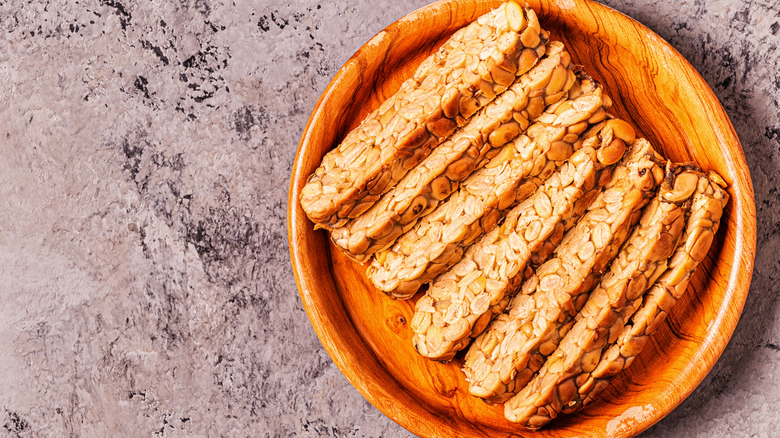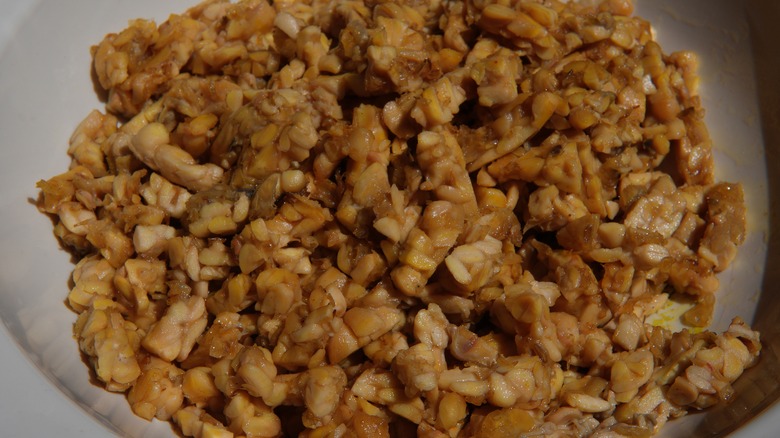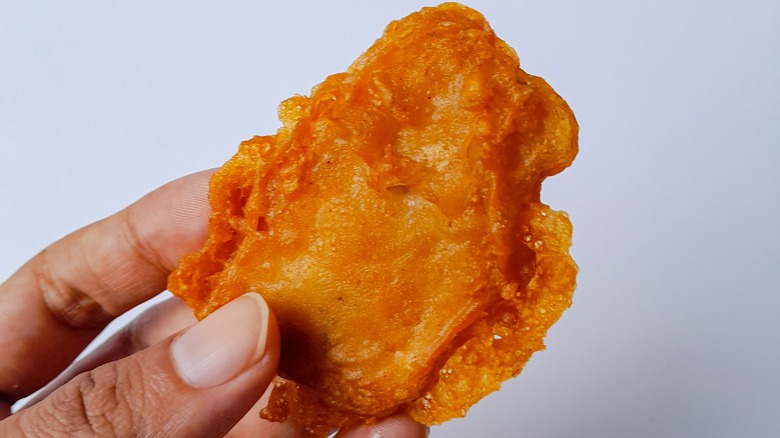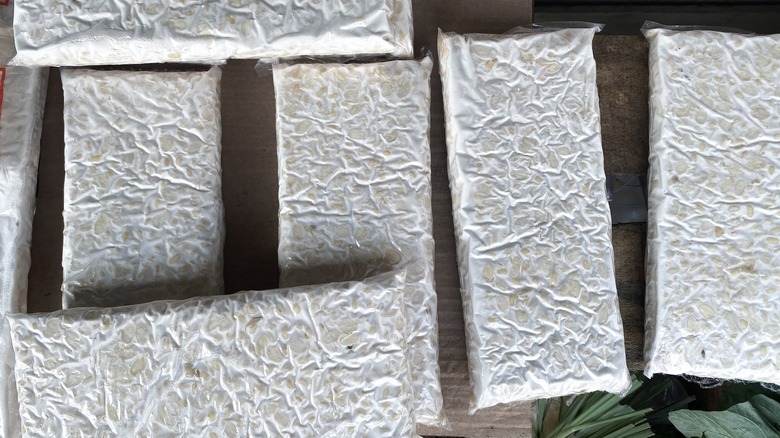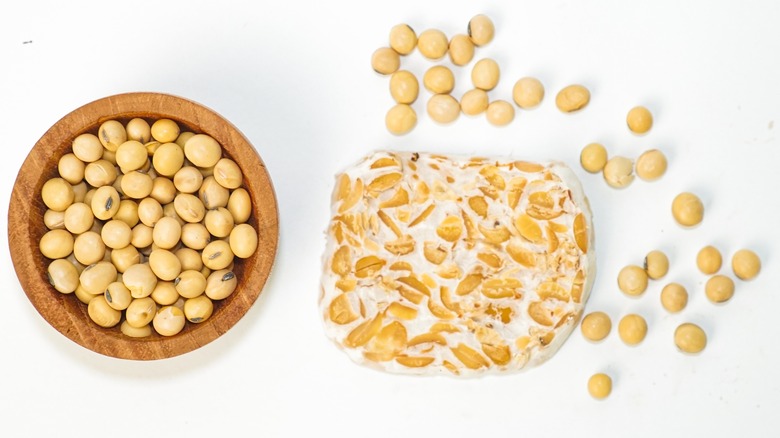What Is Tempeh And The Best Ways To Cook With It
Tempeh is a delicious plant-based protein loved by vegetarians and vegans. However, many people still don't have any clue what it is, and they certainly don't know how to cook it. Even if you know what tempeh is, you may struggle to incorporate it into recipes. No worries — all your questions will be answered in this comprehensive guide.
I've been a vegetarian for more than 30 years — I have made and experimented with tempeh more times than I can count. Personally, I don't like tofu all that much, but I love tempeh. For me, the flavor and texture are unbeatable — even though tofu and tempeh are a by-product of soybeans. Either way, keep reading to learn all the helpful cooking tips and methods I've discovered along the way. By the time you're done, not only will you know what tempeh is and how to cook with it, but you may even be excited to give it a try and share it with friends. From potential recipes to various cooking methods to a full explanation of how it is made and what it tastes like, here's everything you ever wanted to know about tempeh.
What is tempeh?
Similar to tofu, tempeh is made from soybeans. However, it is a fermented food product. Other grains, beans, and legumes can also be used to make tempeh, but soybeans are the classic and most commonly used ingredient. While you may not have heard of tempeh, it has actually been around for about 400 years. According to Google Arts & Culture, tempeh was first documented in the 1600s in Central Java, Indonesia, in the Tembayat Village of Klaten. It is a staple source of protein for Indonesians and is still widely consumed there and in Malaysia.
Whichever grains are used to make a particular type of tempeh, they undergo a fermentation process and are pressed into solid cakes, perfect for cutting and cooking in many ways. It is vegetarian, vegan, and, most of the time, gluten-free. However, some companies use varying grains that contain gluten, so you always want to double-check if this is a concern for you. Either way, it is a fantastic source of protein, and its versatile texture and taste make it an excellent low-fat substitute for meat in almost any dish.
This is how tempeh is made
Making tempeh requires a considerable amount of time, but the finished result is well worth the effort. First, soybeans are soaked overnight. Then, they are dehulled and cooked in boiling water for approximately 30 minutes to one hour. After draining and cooling, the soaked and cooked soybeans are then inoculated with mold to initiate fermentation. Critical Reviews in Microbiology reports that mold from the genus Rhizopus is typically used.
During fermentation, the soybeans are wrapped or packed. Traditionally, banana leaves and other kinds of leaves are used. However, plastic is more common in current times, especially in the United States. Once wrapped, the soybeans and mold are left to incubate. The process takes anywhere from 24 to 72 hours to achieve the appropriate level of fermentation. Once fermentation is complete, the mold and soybeans form a dense cake kept intact by a cottony film of mycelium. For the finishing step, the wrapping is removed, and you are left with fresh, delicious tempeh ready for cooking and consumption.
This is what tempeh tastes like
Some people think tempeh smells like fresh mushrooms, but it actually has a rich, nutty flavor. It also has lots of yummy umami elements that enhance the grainy texture and complement a limitless amount of dishes. When cooked, the fermented flavor virtually disappears, so you won't taste it like you would with kimchi or beer. Instead, you get a mild nutty taste that blends in exceptionally well and is highly versatile.
One of the best things about tempeh is that it easily soaks up the flavors of whatever you cook it with. The soybeans absorb spicy, sweet, and salty ingredients like it is their job. So, essentially, you can make your tempeh taste like whatever you want with a bit of practice. Many people soak it in soy sauce to make the umami taste stronger and bring the meat-like elements to the forefront. Even so, it won't taste anything like meat. Unlike plant-based products such as Impossible or Beyond, tempeh still tastes like beans and won't be similar to meat. Depending on who you talk to, this can be a huge benefit or somewhat of a deterrent. If you're cooking for staunch vegetarians or vegans, chances are good the lack of real meat flavors and textures will be seen as a major plus.
Tempeh vs. tofu: How are they different?
While both tofu and tempeh are soy products, they are actually quite different. In the most basic terms, tofu is made from soy milk, and tempeh is made from soybeans. As a result, tofu has a soft, spongy texture and a grainy, compact consistency. Even though they both come from soybeans and can easily be used as a meat substitute, they are nothing alike when it comes to their texture. They taste different, too. Unlike tempeh, which has a nutty, umami flavor, tofu does not really taste like anything at all. In fact, tofu's spongy, soft feel and lack of flavor are some of the main reasons many people don't prefer it or attempt to cook with it and incorporate it into their diet.
Making tofu may be slightly more manageable and faster than making tempeh, but that isn't enough to make people choose it over tempeh. After all, most people simply buy it from the store pre-made. Another reason many people who are in the know prefer tempeh is because it is healthier and more nutrient-dense than tofu (via Healthline). Comparatively, tempeh is higher in protein, vitamins, and fiber. So, if you're looking to enhance a vegetarian or vegan meal with nutritious, protein-rich ingredients, tempeh is a much better choice than tofu.
Cooking with tempeh
Flavor and potential recipes are not the only things that make tempeh wildly versatile. It can also be cooked using virtually any method. It can be steamed, sautéed, baked, grilled, air-fried, deep-fried, simmered, microwaved, smoked, or even eaten raw. However, eating it raw isn't really recommended. Once it is cooked, it can also be eaten cold, so if you want to throw it in a sandwich, wrap, or salad, there's no need to reheat it either. Whichever way you choose to prepare tempeh, adding some oil or fat to the mix leads to the best results.
A little oil or butter ensures it doesn't become overly dry. For the perfect soft, chewy texture, simmering tempeh in a shallow bath of water with a lid for a few minutes steams the cake all the way through. Then, it can be sautéed, baked, or air-fried to give it a crisp exterior. While this method is often preferred, feel free to play around and experiment with it for your dishes. It is basically impossible to mess it up. If you over-boil it and the grains start to separate, you can always add the crumbled pieces to a dish. Or, if it becomes too hard, use it more like a breadcrumb or a salad topper.
Adding flavor to tempeh
Because tempeh has a somewhat mild taste, adding extra flavor makes it much more enjoyable. Thanks to its versatility, you can enhance it with any sauce, spice, or herb. Marinating tempeh before cooking is one of the easiest ways to enhance flavor throughout. Just like you would with meat, soak it in a bath of spices and sauce. Soy sauce is a favorite for many chefs because it adds a salty element, lots of umami flavor, and a pleasing color. If you forgot to plan ahead or simply don't have time for marinating tempeh, tossing it in sauce after cooking is another fantastic flavor-enhancing option. In addition to saving time, it also helps cooked tempeh stay crispier, so depending on the dish, it could even be preferred.
As we mentioned, simmering leads to a softer texture, but it also helps tempeh absorb yummy spices and herbs. Put seasonings on the tempeh and in the water while it simmers for optimal results. Steaming tempeh for a couple of minutes also helps minimize its somewhat bitter taste, so many people start with this. Lastly, when you maximize the surface area exposed to seasonings, tempeh does a better job of absorbing flavor. So, cutting it into thin slices makes an excellent choice if you want every single bite to be packed with drool-worthy goodness.
Cut a slab of tempeh in half for hearty sandwiches
Cooking tempeh is pretty straightforward, no matter how you do it. Regardless, if you want to make the task as simple as possible, minimize slicing and simply cut a slab in half or thirds and cook as is. Most brands of tempeh sell their product in the form of a thick rectangular cake. While slicing it thin is an option, it is not a requirement. Instead, you can cut the long piece in half, simmer, and then sauté to get a tasty, soft texture perfect for sandwiches. When done this way, it is the ideal shape for bread, and it creates a hearty sandwich, sub, or any kind of sandwich you like.
Cutting and cooking a half slab of tempeh also makes it the perfect size and shape for a burger bun. It won't be round, but the thickness and size are excellent. Sure, you can buy plenty of easy veggie burgers frozen from the grocery store, but they don't always have as much nutrition packed into their ingredients as tempeh does. As far as using tempeh as a patty, it's an outstanding alternative to meat. It doesn't require any molding, mixing, or figuring out how to get ingredients to stick together. Instead, it is pre-shaped and ready for use.
Cut tempeh into cubes or triangles and use as a meat substitute
As you've probably started to notice, tempeh is a phenomenal substitute for meat. When you cut it into larger chunks, cubes, or thick triangles, it makes a great replacement in classic meat dishes. It won't convince anyone they are eating meat, like a new-aged fake meat product might, but it is an outstanding stand-in. Many vegetarians don't like the taste of meat either, so it is perfect for them.
Whether you're making a burrito bowl or a hearty protein bowl over rice and veggies, tempeh is the ideal ingredient. When marinated and flavored right, like in a sesame-peanut tempeh bowl, it blows other meat substitutes out of the water. Its ability to absorb flavors and distribute a soft yet grainy texture throughout the bowl is undeniably delicious. So much so that your meat-eating friends are sure to enjoy it, too. Once cooked and chilled, leftover triangles and cubes of tempeh also make a wonderful addition to salads. Similar to a cobb salad but vegetarian, they add a good amount of bite and are hearty enough to help fill you up.
Cut tempeh into thin slices for wraps, salads, and more
Thin slices of tempeh make the perfect complement for a nearly limitless amount of dishes, but salads and wraps really make them shine. They add just enough of a hearty element without overpowering the rest of the dish. Thinner slices also break up nicely while eating but stay intact long enough to make a dish look appetizing. There's no need for a knife, either. They cook up quickly, and you can often forgo the simmering stage to get extra crispy results. Once cooked and cooled, these thin slices are perfect for taking out of the fridge and putting directly on your salad or in a wrap without reheating. Of course, they are delicious hot, too, but thin refrigerated slices are where it is at if you're making lunch to-go.
Thinner tempeh slices are also ideal for enhancing flavor through seasoning, marinating, and more. The additional surface area gives more grains within exposure to spices, sauces, and herbs, leading to a serious increase in yummy flavors throughout. So, thin slices are the way to go if you want tons of seasoning in every bite. You don't have to limit yourself to salads and wraps, either. They just have the right shape and thickness for these dishes, but it doesn't have to stop there.
Crumble tempeh and add it to virtually anything
Breaking up a slab of tempeh in small crumbles may seem counterintuitive since so much effort went into making it a cohesive piece. Still, it is a fantastic way to incorporate it into a variety of dishes. Similar to textured vegetable protein, crumbled tempeh is an easy addition to thick sauces like marinara, hearty soups such as chili, and more. It is an excellent stand-in for meat in tacos and can also be tossed into a stir-fry.
Once broken up, tempeh blends into recipes and adds little bursts of texture and flavor throughout. If you are trying to sneak it in for a picky kid or unassuming adult, crumbling is the best way. They may even think it is just hamburger meat in a thick sauce like marinara. Another benefit of crumbling tempeh is that it cooks much faster than when left in larger chunks. There is no need to simmer it first, either. Unless, of course, you prefer to eliminate any bitterness. Even so, steaming crumbled tempeh can leave it somewhat soggy.
Batter and fry tempeh for extra crunch
Tempeh can also be battered and fried to give it a delightful, crunchy texture. Like tempura or fritters, the tempeh stays soft and chewy inside but is coated with a flaky, savory crust perfect for dipping in a world of different sauces. From ponzu to peanut to buffalo to green goddess dressing to flavored aioli, the neutral nutty flavor of tempeh and breading goes with almost any sauce you have in mind. Battered and fried tempeh also makes a fantastic addition to wraps, sandwiches, salads, tacos, and more. Battering and frying foods obviously makes them less healthy than when consumed in their natural form, but thanks to all the protein in tempeh, you don't have to feel too bad about this delectable creation.
Making tempura batter at home for tempeh is relatively easy. All you need is water, flour, and an egg yolk. Whisk the chilled ingredients together, dip your tempeh in a layer of flour, and coat it with the batter. Then, fry the pieces in hot oil between 335 and 355 degrees F until golden and crispy. The great thing about making this tempura batter is that you can easily fry other veggies or even meat along with the tempeh to create a more elaborate, well-rounded selection of crispy goodness. If you're cooking for vegetarians, just make sure you don't cross-contaminate the tempeh and veggies with meat.
Where to buy tempeh
Even if you've never seen it before, there's a good chance your local grocery store carries tempeh. It is typically kept next to the tofu and other plant-based meat substitutes in the refrigerated section. If you can't find it at your run-of-the-mill grocery store, health food stores like Whole Foods are a sure thing. In fact, you're likely to find a reasonably good selection with more than one kind at specialty stores. Many farmers' markets also feature small tempeh stands.
One of the most popular brands of tempeh, Lightlife, has a convenient locator tool on their site that shows you places nearby where you can find it on shelves. While this is the most common brand, Trader Joe's also sells their own brand of tempeh, and several other types can be found at various stores. Finally, if you can't seem to locate any tempeh around town, online purveyors won't let you down. From Amazon to Pinemelon, ordering it online is quite easy, and it isn't all that expensive.
Purchase Lightlife Original tempeh on Amazon for $5.49.
Purchase Tofurky Original Treehouse tempeh on Azure for $2.93.
Purchase Little House of Tempeh Black Bean on Pinemelon for $5.79.
Nutritional benefits of tempeh
Thanks to tempeh's compact structure, it is more nutritionally dense than other soy products. So, if you want to add protein and vitamins to your recipe, it makes a phenomenal plant-based choice. It is rich in fiber, low in fat, and contains lots of iron, calcium, magnesium, and phosphorus. All combined, it is not only healthy but also poses several benefits for your body (via WebMD). First, its high fiber content is excellent for gut health. The calcium within is also beneficial for bone health.
According to The American Journal of Clinical Nutrition, studies suggest that soy isoflavones can help reduce cholesterol levels, both overall and specifically for low-density lipoprotein, which is commonly referred to as bad cholesterol. The same soy isoflavones are also potent antioxidants, so they reduce oxidative stress caused by free radicals.
BBC Good Food notes that tempeh is excellent for a strong immunity, since it contains all nine essential amino acids — it also promotes growth and muscle recovery. Its protein-rich form is filling, so some people like using it to help manage portion intake and regulate appetite.
How to store tempeh
When you pick up tempeh from the grocery store, you grab it out of a refrigerated area. So, when you bring it home, you'll also want to keep it in the fridge. It is not nearly as perishable as meat products, but keeping it cool ensures it lasts for quite a long time. Unopened packages typically last for a few weeks. Even so, you should always check the expiration date on the wrapper. As most of us already know, expiration dates are more of a suggestion than a hard deadline. Still, they are worth taking note of and using as a general guideline.
Occasionally, uncooked tempeh can start to form discolored sections, and some of the individual beans will darken and turn almost black. When this happens, you don't need to toss it out. It should still be good. After cooking or opening a package of raw tempeh, you need to keep it in an airtight container in the fridge. If you do, it should remain edible for several days. If you don't plan on eating it anytime soon, whether cooked or not, feel free to toss it in the freezer to extend shelf life even more. When frozen, tempeh lasts for months without issue.

